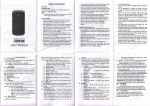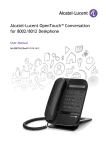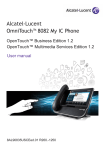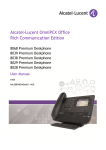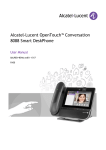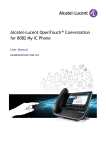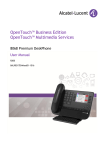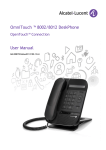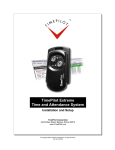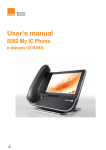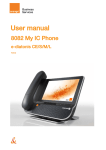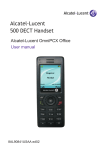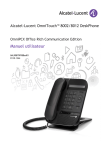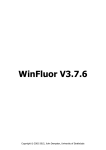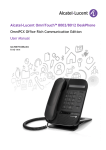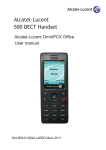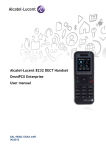Download Alcatel-Lucent OpenTouch™ Connection for 8082 My IC Phone
Transcript
Alcatel-Lucent OpenTouch™ Connection
for 8082 My IC Phone
User Manual
R100
8AL90883ENAAed.01 R100-1340
Introduction
Thank you for choosing an Alcatel-Lucent phone.
This model offers enhanced ergonomical features for more effective communication.
Its innovative and high-quality design will improve your corporate communications and allow access to
a variety of services.
2
1. GETTING TO KNOW YOUR TELEPHONE
1.1.
1.2.
1.3.
1.4.
1.5.
1.6.
1.7.
1.8.
6
TOUCH SCREEN
THE OPENTOUCH™ CONNECTION WELCOME SCREENS
KEYS TAB
PERMANENT FEATURES KEYS
VIRTUAL KEYBOARD.
CALL MANAGEMENT SCREEN
DEVICE SETTINGS SCREENS
MY IC PHONE BLUETOOTH® WIRELESS HANDSET
7
8
9
10
10
11
12
13
2. USING YOUR TELEPHONE
14
2.1.
2.2.
2.3.
2.4.
2.5.
2.6.
2.7.
2.8.
2.9.
2.10.
2.11.
2.12.
14
14
14
15
15
15
15
16
16
16
17
17
MAKING A CALL
RECEIVING A CALL
USING THE TELEPHONE IN "HANDS FREE" MODE
ACTIVATING THE LOUDSPEAKER DURING A CONVERSATION (RECEIVER LIFTED) - LOUDSPEAKER.
CALLING YOUR CORRESPONDENT BY NAME (COMPANY DIRECTORY)
MAKE CALLS VIA YOUR PROGRAMMED CALL KEYS
REDIALING
CALL BACK AN UNANSWERED CALL
REQUESTING AUTOMATIC CALLBACK IF INTERNAL NUMBER IS BUSY
RECEIVING INTERCOM CALLS
SENDING DTMF SIGNALS
MUTE, SO THAT YOUR CORRESPONDENT CANNOT HEAR YOU
3. DURING A CONVERSATION
18
3.1.
3.2.
3.3.
3.4.
3.5.
3.6.
3.7.
3.8.
3.9.
3.10.
3.11.
18
18
19
19
19
19
20
20
21
21
21
MAKING A SECOND CALL DURING A CONVERSATION
ANSWERING A SECOND CALL DURING A CONVERSATION
SWITCHING BETWEEN CALLS (BROKER CALL)
TRANSFERRING A CALL
THREE-WAY CONFERENCE WITH INTERNAL AND/OR EXTERNAL CORRESPONDENTS (CONFERENCE)
TALK SIMULTANEOUSLY TO MORE THAN 2 CORRESPONDENTS
PLACING A CALL ON HOLD (HOLD)
PLACING AN OUTSIDE CALL ON HOLD (PARKING)
INTRUSION INTO AN INTERNAL CONVERSATION
ADJUST AUDIO VOLUME
SIGNAL MALICIOUS CALLS
3
4. SHARING
22
4.1.
4.2.
4.3.
4.4.
4.5.
4.6.
4.7.
4.8.
4.9.
4.10.
4.11.
22
22
22
23
23
23
23
24
24
25
25
ANSWERING THE GENERAL BELL
MANAGER/ASSISTANT FILTERING
CALL PICK-UP
HUNTING GROUPS
CALLING AN INTERNAL CORRESPONDENT ON HIS/HER PAGER
ANSWERING A CALL ON YOUR PAGER
CALLING A CORRESPONDENT ON HIS/HER LOUDSPEAKER
SENDING A WRITTEN MESSAGE TO AN INTERNAL CORRESPONDENT
SEND A VOICE MESSAGE COPY
SENDING A RECORDED MESSAGE TO A NUMBER / A DISTRIBUTION LIST
BROADCASTING A MESSAGE ON THE LOUDSPEAKERS OF A STATION GROUP
5. KEEP IN TOUCH
26
5.1.
5.2.
5.3.
5.4.
5.5.
5.6.
5.7.
5.8.
5.9.
5.10.
5.11.
5.12.
26
26
26
26
27
27
27
27
28
28
28
29
DIVERTING CALLS TO ANOTHER NUMBER (IMMEDIATE DIVERSION)
DIVERTING YOUR CALLS TO YOUR VOICE MESSAGE SERVICE
WHEN YOU RETURN, CONSULT RECORDED MESSAGES
DIVERTING CALLS TO YOUR PAGER
FORWARDING YOUR CALLS FROM THE RECEIVING TERMINAL ("FOLLOW ME")
APPLYING A SELECTIVE DIVERSION
CANCELING ALL DIVERSIONS
CANCELLING A SPECIFIC DIVERSION
DIVERTING CALLS
DO NOT DISTURB
LEAVING A RECORDED MESSAGE FOR INTERNAL CALLERS
CONSULTING WRITTEN MESSAGES
6. MANAGING YOUR CHARGES
30
6.1. CHARGING YOUR CALLS DIRECTLY TO BUSINESS ACCOUNTS
6.2. FINDING OUT THE COST OF AN OUTSIDE CALL MADE FOR AN INTERNAL USER FROM YOUR TERMINAL
30
30
4
7. PROGRAMMING YOUR TELEPHONE
31
7.1.
7.2.
7.3.
7.4.
7.5.
7.6.
7.7.
7.8.
7.9.
7.10.
7.11.
7.12.
7.13.
7.14.
7.15.
7.16.
7.17.
7.18.
7.19.
7.20.
7.21.
7.22.
7.23.
7.24.
7.25.
7.26.
7.27.
7.28.
31
31
31
32
32
33
33
33
34
34
34
34
35
35
35
35
35
36
36
36
36
37
37
38
38
39
39
39
INITIALIZING YOUR VOICE MAILBOX
CUSTOMIZING YOUR VOICE GREETING
MODIFY THE PASSWORD FOR YOUR PHONE SET
MODIFY THE PASSWORD FOR YOUR VOICE MAILBOX
ADJUSTING THE AUDIO FUNCTIONS
ADJUSTING THE CONTRAST OF THE DISPLAY
SELECT THE SCREENSAVER DELAY
SELECT THE RIGHT OR LEFT TYPE OF DISPLAY
SELECT THE KEYBOARD TYPE
SELECTING THE WELCOME PAGE
SELECTING LANGUAGE
PROGRAM THE KEYS FOR THE PERSO PAGE
PROGRAMMING DIRECT CALL KEYS (F1 AND F2 KEYS )
DELETE A PROGRAMMED KEY
PROGRAMMING AN APPOINTMENT REMINDER
IDENTIFY THE TERMINAL YOU ARE ON
LOCK / UNLOCK YOUR TELEPHONE
CONFIGURING THE AUDIO JACK OF YOUR TELEPHONE
CALL THE ASSOCIATED SET
FORWARD YOUR CALLS TO THE ASSOCIATED NUMBER
MODIFY THE ASSOCIATED NUMBER
THE TANDEM CONFIGURATION
CREATE, MODIFY OR CONSULT YOUR INTERCOM LIST (MAX. 10 NUMBERS)
INSTALLING A BLUETOOTH® WIRELESS TECHNOLOGY HANDSET (MATCHING)
USE OF THE BLUETOOTH® HANDSET
INSTALLING A BLUETOOTH® WIRELESS TECHNOLOGY HEADSET (MATCHING)
USING A BLUETOOTH® WIRELESS TECHNOLOGY HEADSET
DELETING AN ACCESSORY (HEADSET, HANDSET, ETC.): BLUETOOTH® WIRELESS TECHNOLOGY
8. GUARANTEE AND CLAUSES
40
8.1. SAFETY INSTRUCTIONS
40
8.2. THE OMNITOUCH™ 8082 MY IC PHONE ALSO OFFERS A BLUETOOTH® RADIO INTERFACE FOR THE BLUETOOTH® HANDSET
OR OTHER BLUETOOTH® DEVICESREGULATORY STATEMENTS
40
5
1. Getting to know your telephone
A sensitive LCD wide screen
1
Permanent feature keys: quick access to the phone’s
main features
2
A Bluetooth® handset for optimized communication. A
wired handset is also available and can replace the
Bluetooth® handset.
3
A wideband speaker for optimized sound
4
LED
Arrival of a new call (Flashing)
5
An adjustable and stable foot
6
One 3.5 mm headset jack
7
Various connections to allow phone extensions
8
Add-on module connector (SATA type). 2 USB
connectors
1 mini-USB connector for a keyboard (1)
Two 10/100/1000 Mbps Ethernet connectors to
enterprise network (LAN) and a PCOne DC power jack
for an external power adaptor
1 RJ9 connector for a corded handset
(1) Not yet released
6
1.1. Touch screen
To handle your calls and the features of your phone, the set provides a touch screen and permanent
features keys.
The touch screen is divided in 4 areas dedicated to :
Time, date and
informative icons
The OpenTouch™ Connection
Welcome screens
The pads
Key tab
Time, date and informative icons
This display is located at the top of the Touch screen. Date, time and informative icons (such as headset plug, lock
status, etc.) are displayed in this area.
Pads
They can be of two kindsThe dialpad allows you to dial numbers and fill text field with numeric
characters.
The dialpad allows you to dial numbers and populate text fields with numeric characters. The
alphapad is useful for quick access to the dial by name feature and complements the virtual keyboard.
Use this key associated to the pads, to switch from the dialpad to the
alphapad.
7
1.2. The OpenTouch™ Connection Welcome screens
You can access all of your phone features from these screens. The default display has three pages that
you can access by pressing the page tabs at the top of the screen. The selected page is highlighted.
o
o
o
menu
perso
info
Navigation : to navigate on these pages,
Use the Up and
Down arrows to go
up or down on a
page showing
details not
displayed on a
single page.
Use this key to go
back to the previous
step.
Use this key to
validate a choice,
data entered, …
Menu page:
Contains all functions and applications accessible by pressing on the label of the desired
feature or application. From this page, it is possible to adjust the ringer volume, program the
time of an appointment, lock the terminal, define the default page displayed, configure voice
mail, and access telephone functions such as calling back one of the last numbers or
intercepting calls.
8
Perso page:
Contains call line keys (allowing supervision of calls) and programmable call keys.
Info page:
Contains information on the telephone and the status of its functions: name, telephone
number, number of messages, activation of transfer function, appointment reminder, etc.
1.3. Keys tab
These keys are displayed at the bottom of the screen.
‘Redial’ key : to access the 'Redial'
feature.
END key: to end a call or return to idle
mode (the key is red when the line is
taken or you are browsing through the
menus).
Messaging key to access various mail
services:This key is blinking when you
received a new voice message, a new text
message or a callback request and is lit in
case of missed calls. When not lit, you can
access to various message services.
9
Programmable key (F1 and F2 keys) : Lit
when the function associated with the key
is activated
A service or a direct call can be associated
to these keys.
1.4. Permanent features keys
They are located just below the touch screen.
Mute and interphony key.
In conversation press this key so that your correpondent doesn’t hear you. In idle state press
this key to set up the phone in interphony mode. When you receive a call, the phone hooks off
automatically and you are directly in conversation in handsfree mode. When activated, the
key is lit blue.#
Turn down the volume.
Turn up the volume.
Pressing this key answers an incoming call in handsfree mode (the key is blue). When a call is
in progress, pressing this key switches from handsfree mode to headset or handset mode.
Pressing this key will access to the routing menus.
This key is lit when you received a new voice message, a new tex message or a callback
request. When not lit you can access to various message services. This key is blinking in case
of a missed call.
Activate or deactivate the virtual keyboard.
In idle mode, pressing this key takes you to the device settings menu. You can then choose the
type of display (left or right) and/or the type of keyboard you want to use (AZERTY, QWERTY,
QWERTZ, etc.). You can also adjust some screen settings.
Pressing this key brings the phone in idle mode when navigating in pages and configuring the
phone.
1.5. Virtual keyboard.
This keyboard is accessed by pressing the keyboard key (
by name" feature, and entering names, texts, data, etc.
). It is designed for accessing the "Dial
When you first press the virtual keyboard key, the keyboard is shown such as below.
10
Here is a list of the functional keys that help you to access all symbols.
Cursor moving keys (left, right, up and down). Helps you to navigate in an edit
box. Press Alt key to access the left and up navigation
Caps lock. To write text in capital letters.
Alt key. To access to characters or functions in purple color.
Numbers key. To access numbers as well as specific characters.
Enter key. To validate a edited text.
Backspace key: to delete one character in an edit box.
1.6. Call management screen
Call holding icon
Incoming call icon
Call in progress icon
Incoming call and
conversation
presentation screen.
Soft keys: actions available
depending on the call status
Each tab corresponds to a call and its status is symbolized by its icon (in progress, held, arrival
of new call).
All features accessible while the call is displayed on the screen. Use the Up and Down arrows
to go down or up on a page These functions (transfer, conference, etc.) are directly related to
the status of the call consulted. For example, the transfer function will not be available
between a call in progress or a held call and an incoming call.
Used to switch from a telephone screen to an application screen and to browse a
device menu.
Calls can also be managed from the Perso page.
While the call is in progress, press the Back/Exit key and display the Perso page. Calls in
progress or waiting calls are displayed on the different line keys. It is then possible to converse
with the caller of your choice by pressing the key associated to the caller.
11
1.7. Device settings screens
: open the device settings menu
Screen contrast
Screensaver delay
Type of display
(right/left)
Go to next page
Type of keyboard
Go to previous page
Note : to adjust the screansaver timeout, tap several times on the timeout value to access other
available values.
12
1.8. My IC Phone Bluetooth® Wireless handset
Off-hook/On-hook: press this key to take or
terminate a call
Volume/Mute:
LED
Short successive
presses to change the
handset volume level
(3 levels)
Long press to activate
or deactivate mute
mode
Location of the battery
If the Bluetooth® handset is on its base, you do not need to press the Off-hook/On-hook key to take or
terminate the call. Just off-hook/on-hook the Bluetooth® handset.
LED
Off: operating normally
Blinking green: in communication
Green steady: handset charging
Orange flashing: battery charge low or handset outside coverage zone
Orange steady: malfunction
Installing or replacing the Bluetooth® handset battery
Lift up the battery cover
Slide out the battery holding
part
The battery recharges when the Bluetooth® handset is on its base.
13
2. Using your telephone
2.1. Making a call
Use one of the following different ways
Dial directly the number for your call
Lift the receiver Enter the destination number
Press the on/off hook key of the Bluetooth® device (IP Touch Bluetooth® Wireless handset)
Dial the destination number
Hands free Dial the destination number
Programmed line key
Search by name (you can also access the search by name feature via the alphapad)
To make an external call, dial the outside line access code before dialing your contact number
2.2. Receiving a call
Use one of the following different ways
Lift the receiver
Press the on/off hook key of the Bluetooth® device (IP Touch Bluetooth® Wireless handset)
Hands free
Take call
Select the « incoming call » icon
2.3. Using the telephone in "Hands free" mode
Terminal idle:
Press and release
You are in hands free mode
Terminate your call
Call in progress:
During a conversation
Press and release
You are in hands free mode
During a conversation, you can lift the receiver without terminating the call.
14
2.4. Activating the loudspeaker during a conversation (receiver lifted) Loudspeaker.
During a conversation
Activate loudspeaker ,
Adjust volume (9 levels) :
Deactivate loudspeaker
The key lights up
The key is no longer lit
Press and release the loudspeaker key to switch to hands free mode (light steady).
2.5. Calling your correspondent by name (company directory)
Enter the name or initials or the surname and first name of your correspondent
Select the type of search you want (last name, last name and first name or initials)
of all the correspondents meeting the search criteria
Use one of the following different ways
o
o
Display
Select the name of the person you wish to call
Modify the search
* Name must be entered in format namespacefirst name.
You can also search by initials. Type the initials of first name and surname, separated by a space. All
first names/names matching these initials will be displayed in the search
2.6. Make calls via your programmed call keys
Access the "Perso" page
Find the correspondent you want to call from the programmed call keys
Select the correspondent
2.7. Redialing
Redialing the last number dialed (redial)
(long press)
Last number redial
Call back one of the last 8 numbers dialed
(short press)
Select the number to redial from the last dialed numbers
You can access to this feature too by menu :
Reach the "Menu" page
Redial list
Last number redial
Select the number to redial from the last dialed numbers
15
2.8. Call back an unanswered call
No Reply calls (the number of new unanswered calls is displayed)
Select the type of call:
o No non replied internal calls / xx non replied internal calls
o No non replied external calls / xx non replied external calls
Select a name or a number
Recall
To delete the selected item
Delete
Erase the list of unanswered calls
No Reply calls (the number of new unanswered calls is displayed)
Select the type of call :
o No non replied internal calls / xx non replied internal calls
o No non replied external calls / xx non replied external calls
Delete all (or use icon:
)
2.9. Requesting automatic callback if internal number is busy
Internal number busy
Call back
Callback request acknowledged
2.10. Receiving intercom calls
You can answer a call without lifting the receiver. When you receive a call, you are automatically
connected in hands-free mode. The identity of the caller is displayed on the screen.
a.
To activate - Terminal idle:
Corresponding LED lights up
When your caller hangs up, intercom mode remains active.
b. To deactivate - Terminal idle:
The corresponding LED goes out
16
2.11. Sending DTMF signals
During a conversation you sometimes have to send DTMF signals, such as with a voice server, an
automated attendant or a remotely consulted answering machine.
During a conversation
Send DTMF
Enter DTMF code
The function is automatically cancelled when you hang up.
2.12. Mute, so that your correspondent cannot hear you
You can hear your correspondent but he/she cannot hear you:
From the set
During a conversation
Disable microphone
Resume the conversation
The key lights up
The key is no longer lit
From the Bluetooth® receiver
Press the handset volume/mute key (long press)
17
3. During a conversation
3.1. Making a second call during a conversation
During a conversation
New call
Number of second correspondent
The first call is on hold
Other methods for calling a second correspondent
Dial directly the number for your call.
Name of second correspondent.
Select the "Redial" function
Programmed line key.
To cancel your second call and recover the first:
You are in conversation with the second correspondent and the first one is on hold.
Use one of the following different ways :
o Enquiry off
o
Hang up
You are in conversation with your first correspondent
If you make an error, hang up: your telephone will ring and you will recover your first call.
3.2. Answering a second call during a conversation
During a conversation, another person is trying to call you
Name or no. of the caller
displayed for 3 seconds
Use one of the following different ways to answer displayed call
o
Line key for which icon is flashing
o Take call
The first call is on hold
To return to your first caller and end the conversation in progress
The second call is ended
To recover the first correspondent, use one of the following different ways
o
Select the « incoming call » icon
o
o
Lift the receiver
18
3.3. Switching between calls (Broker call)
During a conversation, a second call is on hold.
To accept the second call:
Select the correspondent on hold
Your first call is placed on hold
3.4. Transferring a call
To transfer your call to another number:
During a conversation
Calling a second person during a conversation
The first call is on hold
You can transfer immediately the call or wait for your contact to answer before transfer the
call
Transfer
Transfer between two outside calls is not generally possible (depends on country concerned and
system configuration).
3.5. Three-way conference with internal and/or external correspondents
(conference)
During a conversation, a second call is on hold
Conference You are in conference mode
Cancel conference and return to first correspondent (If conference is active)
End conference
Hang up on all correspondents (If conference is active)
Hang up
After the conference, to leave your two correspondents talking together:
Transfer
Hang up
3.6. Talk simultaneously to more than 2 correspondents
You are in a conference call with 2 correspondents. To add another correspondent to the conference:
Add
Dial the number of your correspondent (dial, directories, last numbers dialed...)
Your correspondent answers
Insert You are in conversation with additional correspondent
During a 3-way conference, you can add up to three additional participants.
19
3.7. Placing a call on hold (hold)
Exclusive hold:
During a conversation, you wish to place the call on hold and recover it later, on the same telephone.
During a conversation
Put on hold
Your call is placed on hold
Recover the call on hold:
Select the call on hold
Common hold:
To recover your call on any telephone in your system.
During a conversation
Hold
Your call is placed on hold
Recover the call on hold from any telephone:
Select the call on hold
3.8. Placing an outside call on hold (parking)
You can place an outside call on hold and recover the call on another telephone:
During a conversation
Park the call
A parking announcement message is displayed on the screen of the parking destination set.
To recover the parked call:
To automatically take the parked call, pick up the handset of the parking destination set.
Reach the "Menu" page
Settings My services Consultation
Call pick up services
Park/Retrieve call
If the parked call is not recovered within a preset time (default value 1 min 30), it is transferred to
the operator.
20
3.9. Intrusion into an internal conversation
Your correspondent's line is busy. If the number is not "protected" and if authorised, you can intrude
into the call:
Intrusion
Same key to exit (Intrusion)
Protection against intrusion:
Press programmed key
Enter correspondent's number
Protection is cancelled when you hang up.
3.10. Adjust audio volume
During a call, to adjust the volume level of the loudspeaker or receiver:
During a conversation
Adjust audio volume
3.11. Signal malicious calls
This key lets you signal a malicious call. If this call has an internal source, it is signalled to the system
by a special message.
You receive a malicious call
Malicious
21
4. Sharing
4.1. Answering the general bell
When the operator is absent, outside calls to the operator are indicated by a general bell. To answer:
Reach the "Menu" page
Settings My services Consultation
Call pick up services
Night service call pick up
4.2. Manager/Assistant filtering
System configuration allows "manager/assistant" groups to be formed, so that the manager's calls can
be directed to one or more assistants.
From the manager's or assistant's telephone:
Press programmed key
Same key to cancel
Incoming calls are filtered by a chosen person (assistant, etc.)
Filtering is indicated on the manager's telephone by the icon corresponding to the "filtering"
programmed key.
4.3. Call pick-up
You hear a telephone ringing in an office where no-one can answer. If authorised, you can answer the
call on your own telephone.
If the telephone ringing is in your own pick-up group:
Reach the "Menu" page
Settings My services Consultation
Call pick up services
Group call pick up
If the telephone ringing is not in your pick-up group:
Reach the "Menu" page
Settings My services Consultation
Number of telephone ringing
Call pick up services
Individ pick up
The system can be configured to prevent call pick-up on certain telephones.
22
4.4. Hunting groups
Hunting group call:
Certain numbers can form a hunting group and can be called by dialling the group number.
Temporary exit from your hunting group:
Reach the "Menu" page
Settings My services Consultation
Enter your group number
Additional service
Out hunting grp
Additional service
In hunting grp
Return into your group:
Reach the "Menu" page
Settings My services Consultation
Enter your group number#
Belonging to a group does not affect the management of direct calls. A specific telephone within a
group can always be called by using its own number.
4.5. Calling an internal correspondent on his/her pager
The number called does not answer and you know that the person called has a pager:
Dial the destination number
Paging
Dial the destination number
Paging in progress is displayed
Your correspondent can answer from any telephone in the system.
4.6. Answering a call on your pager
A call on your pager can be answered from any telephone within the system.
Your pager beeps
Reach the "Menu" page
Settings My services Consultation
Your extension number
Paging
Paging answer
4.7. Calling a correspondent on his/her loudspeaker
Your internal correspondent does not answer. If authorised, you can remotely activate your
correspondent's phone:
Your correspondent does not reply
LS announce
You are connected to the loudspeaker on your correspondent's phone (if he/she
has the hands free function)
23
4.8. Sending a written message to an internal correspondent
Text mail
Send
Use one of the following different ways
o Enter the number of the terminal to receive the message
o Enter the first letters of the name
Choose the type of message
a. Sending predefined message
Predefined msg
Select a predefined message
Apply
b. Sending a message to complete
To complete
Select a predefined message to complete
Complete your message
Apply
c. Sending a new message
Msg to create
Write your message
Apply
d. Sending the previous message
Previous msg
Apply
4.9. Send a voice message copy
New voice message
Personal code
Display number of new and old messages
Consult Forward msg
Number to be called / Correspondent's name (Spell name/
o Send
Send message
o Exit
End of broadcast
24
)
4.10. Sending a recorded message to a number / a distribution list
New voice message
Personal code
Send
Record your message
Exit
End of recording
Number to be called / Correspondent's name (Spell name/
o Send
Send message
o Exit
End of broadcast
)
4.11. Broadcasting a message on the loudspeakers of a station group
A message not requiring an answer can be broadcasted on the loudspeakers within your broadcast
group:
Off hook
Number of broadcast group
Hang up
Speak, you have 20 seconds
The message will only be broadcast on terminals not in use and which have a loudspeaker.
25
5. Keep in touch
5.1. Diverting calls to another number (immediate diversion)
The number can be your home, mobile or car phone, voice mailbox or an internal extension (operator,
etc.).
Immediat fwd
Number to be called
Diversion is acknowledged
You can make calls, but only the destination number can call you.
5.2. Diverting your calls to your voice message service
Imm fwd to VM
Diversion is acknowledged
5.3. When you return, consult recorded messages
The message key is blinking when you received a new voice message, a new text message or a callback
request, and is lit in case of missed calls.
New voice mess
Personal code
Display name of sender, with date, time and ranking of message
Consult
Listen to message
After the message listening, use one of the following different ways
o Replay
Erase message
o Call back
Call back sender of message
o Save
Archive the message
o
/ Exit
Terminate consultation
5.4. Diverting calls to your pager
Callers will thus be able to contact you while you are moving around the company:
Press programmed key
Diversion is acknowledged
26
5.5. Forwarding your calls from the receiving terminal ("Follow me")
You wish to receive your calls in your present location:
Use the "Follow me" function.
Other fwd Remote forward
Dial your extension number
Diversion is acknowledged
If you have a key programmed with this feature, you can access the feature directly
Press programmed key
Dial your extension number
Diversion is acknowledged
5.6. Applying a selective diversion
You can forward your primary number and your secondary number or numbers to different sets.
Reach the "Menu" page
Settings My services Consultation
Select the number to forward
o Principal line selection
o Second line selection
Number receiving diversion
Forward service
5.7. Canceling all diversions
Deactivate
Deactivated forward
To cancel all diversion, you can programme another type of diversion too.
5.8. Cancelling a specific diversion
Programmed key corresponding to type of diversion (group or selective)
27
5.9. Diverting calls
Callers will thus be able to contact you while you are moving around the company:
Use one of the following different ways
o
o Reach the "Menu" page Forward
Other fwd
Select the forward type to program
o Forward on busy
o Forward on no reply
o Forward on busy/no reply
Number receiving diversion
Diversion is acknowledged
If you have a key programmed with this feature, you can directly access to the feature
Press programmed key
Number receiving diversion
Diversion is acknowledged
5.10. Do not disturb
You can make your terminal temporarily unavailable for all calls.
Do not disturb
Enter code when activate
Apply
Diversion is acknowledged
Callers wishing to contact you will see the "Do Not Disturb" message displayed on their sets when they
try to call.
To deactivate the Do not disturb feature, follow the same procedure.
5.11. Leaving a recorded message for internal callers
You can leave a message on your terminal which will be displayed on the screen of the terminal
calling you.
Text mail Fwd to text
Choose the type of message
a. Sending predefined message
Predefined msg
Select a predefined message
Apply
28
b. Sending a message to complete
To complete
Select a predefined message to complete
Complete your message
Apply
c. Sending a new message
Msg to create
Write your message
Apply
To deactivate the forward to text feature :
Text mail Deact fwd text
Deactivate
The text message is displayed
5.12. Consulting written messages
The light indicates that messages have been received.
Number of messages received
New text mail Read message
Display name of sender, with date, time and ranking of
message
Use one of the following different ways
o Recall
Call back sender of message
o save
Record message
o Next message
Next message
o Text answer
Answer with a text message
o
Terminate consultation
29
6. Managing your charges
6.1. Charging your calls directly to business accounts
You can charge the cost of your outside calls to business account numbers.
Reach the "Menu" page
Settings My services Consultation
Number of business account
Number required
Additional services
Business Account code
6.2. Finding out the cost of an outside call made for an internal user from
your terminal
Reach the "Menu" page
Settings My services Consultation
Consultation & Callbacks
30
Charging information
7. Programming your telephone
7.1. Initializing your voice mailbox
Light flashes
Enter your personal code then record your name according to voice guide instructions
Your personal code is used to access your voice mailbox and to lock your telephone.
Your personnal code is composed by 4 digits. A weak personnal code will be rejected by the system:
- Identical 4 digits (0000, 1111,)
- A simple sequence of 4 digits (0123, 1234,)
7.2. Customizing your voice greeting
You can replace the greeting message by a personal message
Voice mail
Personal code
Perso option Greeting msg Perso greeting
End
End of recording
Use one of the following different ways
o Accept
Apply
o Restart
Re-record a message
o Replay
Replay message
Record message
To return to the default message
Normal prompt
7.3. Modify the password for your phone set
Reach the "Menu" page
Settings Phone Password
Old code (4 digits)
Apply
New code (4 digits)
Apply
Enter new password again to confirm
Apply
This code acts as a password controlling access to programming functions and the user ‘Set Locking ‘
function (code by default: 0000).
31
7.4. Modify the password for your voice mailbox
Voice mail
Personal code
Perso options Admin options
New code (4 digits)
Apply
Password
My password
As long as your voice mailbox has not been initialized, personal code is 0000.
7.5. Adjusting the audio functions
Reach the "Menu" page
Settings Phone Ringing
Choose the tune
Select the type of call to which the ringing is to be associated
o Internal call
o External call
Select the melody of your choice (16 tunes)
End adjusting
To adjust other audio features
Adjusting the ringer volume
Level
Select the volume you want : (12 levels)
End adjusting
To adjust other audio features
Activate/deactivate silent mode
More options
o ▫ Silent mode
o ▪Silent mode
To activate
To deactivate
End adjusting
To adjust other audio features
32
Activate/deactivate meeting mode (progressive ringing)
More options
o ▫ Progressive ringing
o ▪ Progressive ringing
To activate
To deactivate
End adjusting
To adjust other audio features
Activate/deactivate discreet ring mode
▫ One beep before ringing / ▫ Three beeps before ringing
▪ One beep before ringing / ▪ Three beeps before ringing
To activate
To deactivate
End adjusting
To adjust other audio features
Adjust ringer volume while a call arrives
Your telephone rings
Adjusting the ringer volume
7.6. Adjusting the contrast of the display
Press device setting menu key
Decrease or increase the constrast of the display
7.7. Select the screensaver delay
Press device setting menu key
Select the screensaver delay by pressing successively on the field associated to « @ » field and
select the desired time. You can choose between 1, 5, 15, 60 or 240 minutes
7.8. Select the right or left type of display
You can choose the pads to be displayed on the left or the right of the touch screen.
Press device setting menu key
Access the next setting device menu page « > »
Select the right or left type of display.
The selected type of display is highlighted.
Go back to idle state.
33
7.9. Select the keyboard type
You can choose the keyboard you want to use (Azerty, qwerty, …).
Press device setting menu key
Access the next setting device menu page « > »
Select the desired keyboard type (azerty, qwerty, …)
The selected type of keyboard is highlighted.
Go back to idle state.
7.10. Selecting the welcome page
This function is used to choose the page displayed by default on the telephone.
Settings
Phone Homepage
Select the default page
7.11. Selecting language
Reach the "Menu" page
Settings Phone Language
Select the language of your choice
7.12. Program the keys for the Perso page
You can program call numbers and functions for the «Perso» page keys.
Access the Perso page using the navigator
Press the key you want to program
To program a number
Speed dial
Enter the number
Enter the name of the key
Apply
To program a function
My services
Follow information displayed on the screen
Other possibilities
Modify
Erase
Modify contents of entry displayed
Delete
34
7.13. Programming direct call keys (F1 and F2 keys)
Press a programmable key (F1 or F2)
o Speed dial
To program a number
o My services
To program a function
Follow information displayed on the screen
7.14. Delete a programmed key
Reach the "Menu" page
Settings Phone Key program Perso page
Access the "perso " page if necessary
o
o
Delete
Select the key to erase
Press a programmable key (F1 or F2)
7.15. Programming an appointment reminder
You can define the time of a temporary reminder (one in 24 hours).
Reach the "Menu" page
Appointment
Enter time of appointment
The "Appointment programmed" icon is displayed on the welcome page.
a. At the programmed time, your telephone rings:
If your calls are diverted to another terminal, the diversion is not applied to the reminder call.
b. To cancel your reminder request:
Reach the "Menu" page
Appointment Delete
The "Appointment programmed" icon disappears from the welcome page.
7.16. Identify the terminal you are on
The number of your telephone is displayed on the "Info" page.
7.17. Lock / unlock your telephone
This icon indicates that the phone is locked.
Reach the "Menu" page
Lock
Enter your password
Your telephone is locked/unlocked
35
7.18. Configuring the audio jack of your telephone
By default, the audio jack of your telephone can be used to connect a headset, hands-free kit or
loudspeaker.
Reach the "Menu" page
Settings Phone Jack plug
Select the type of the device plugged to the jack
o Headset
o External handset
o External Loudspeaker
7.19. Call the associated set
The number of another set can be associated with your set number (See# Modify the associated
number).
To call it:
Reach the "Menu" page
Settings My services Associate
Call from associate
Start the call
7.20. Forward your calls to the associated number
If you have previously defined an associated number, you can forward your calls to this number.
Reach the "Menu" page
Settings My services Consultation Associate services
Use one of the following different ways
o Overflow to associate
For forwarding when you do not answer
o Overflow if busy to associate
For immediate forwarding when your line is busy
o Overflow busy/no rep to assoc
For forwarding if you do not answer or if you are busy
o Deact overflow associate To cancel the forwarding to associate function
Apply
7.21. Modify the associated number
The associated number can be a phone set number, the voice mail number or the pager number.
Reach the "Menu" page
Settings My services Associate
Enter your password
Apply
Modify
Select the new associate number
o Enter the new associated number
o Voice mail
o Speed dial
36
Acceptance of the programming is displayed
7.22. The Tandem configuration
This configuration lets you group two sets under a single call number. Your set is then the main set
and the second set, usually a DECT set, is the secondary set. Each set has its own directory number,
but the tandem number is that of the main set. When you receive a call, the two sets ring
simultaneously. When one of the sets answers, the other set stops ringing. When all the lines of the
main set are busy, the secondary (DECT) set does not ring. The secondary set can still be called by its
own number, but in this case, the tandem function will no longer be taken into account. Most of the
functions are common to the two sets, for example: forwarding, meet-me reminder, the various
messages, etc., while others are specific to each set, for example: individual directory, last number
redial, out of service, set padlock, etc.
For more information regarding this configuration, contact the person in charge of your installation.
7.23. Create, modify or consult your intercom list (max. 10 numbers)
Reach the "Menu" page
Settings My services Interphony
Follow instructions given on display
37
7.24. Installing a Bluetooth® Wireless Technology handset (matching)
Before a Bluetooth® headset can be used, it must be correctly matched to the terminal.
Reach the "Menu" page
Settings Phone Bluetooth
With the handset turned off, press the 2 Bluetooth® handset keys at the same time (long
press)
Add device
You will hear a 3 note signal and the LED will flash green and orange alternately
Searching for Bluetooth® equipment. Wait for the detected equipment type and address to be
displayed
Select the relevant equipment
Add
The 3-note tone indicates that the handset has been installed correctly (the LED flashes
green or orange depending on the battery charge level)
Error messages
The Bluetooth® handset emits a sequence
of 4 beeps
The set displays an error message
indicating that the set and the Bluetooth®
handset are incompatible
Your set is an older generation than your
Bluetooth® handset
Your Bluetooth® handset is an older
generation than your set
7.25. Use of the Bluetooth® handset
The Bluetooth® cordless handset permits the user to answer and converse with complete freedom
within a radius of 10 meter from the set.
The handset has a LED and two buttons.
Light
Green flashing: normal operation.
Green steady: handset charging.
Orange flashing: battery charge low or handset outside coverage zone.
Orange steady: malfunction.
Off-hook/On-hook and Volume/Mute keys
Off-hook/On-hook: press this key to take or terminate a call.
Volume/Mute:
o Short successive presses to change the handset volume level (3 levels)
o Long press to ensure your correspondent no longer hears you
If the Bluetooth® handset is on its base, you do not need to press the Off-hook/On-hook key to take or
terminate the call. Just off-hook/on-hook the Bluetooth® handset
38
7.26. Installing a Bluetooth® Wireless Technology headset (matching)
Before a Bluetooth® headset can be used, it must be correctly matched to the terminal. Reach
the "Menu" page
Settings Phone Bluetooth Add device
Searching for Bluetooth® equipment. Wait for the detected equipment type and address to be
displayed
Add
Validate your choice
Enter the PIN code of the headset *
Select the relevant equipment
Acknowledgement message and display of the headset icon on the terminal screen
* Refer to the user documentation supplied with the headset.
7.27. Using a Bluetooth® Wireless Technology headset
Refer to the user documentation supplied with the headset.
7.28. Deleting an accessory (headset, handset, etc.): Bluetooth® Wireless
Technology
Reach the "Menu" page
Settings Phone Bluetooth
My devices
Display of the different equipment matched
Select the equipment to be removed
Remove dvc
Validate your choice
Message acknowledging the equipment has been removed
39
8. Guarantee and clauses
8.1. Safety Instructions
Changes or modifications to the equipment not expressly approved by the party responsible for
compliance could void the user’s authority to operate the equipment.
Magnets could affect the functioning of pacemakers and implanted heart defibrillators. Keep a
safe distance between your pacemaker or implant defibrillator and the handset which includes
magnetic elements: 4 centimeters (1,6 inches) at least
To limit the risk of interference, people with pacemakers must keep the wireless telephone away
from their equipment (minimum distance of 15 cm/6 inches)
It is recommended to follow the standard acceptance procedures before using this equipment in
human safety critical areas (hospitals...).
The handset includes magnetic elements that may attract sharp metallic objects. To prevent
injury, before each use ensure sharp metallic objects are not stuck to the earpiece.
There is a danger of explosion if the battery is replaced incorrectly - use only the battery with the
reference 3GV28041AB (1.2V 1500 mAh) (Bluetooth® Handset only).
Battery charge (Bluetooth® Handset only): Charge the battery for about 16 hours before initial
use
Avoid using phones (other than cordless) during an electrical storm. There may be a remote risk of
electric shock from lightning
Do not use the device in environments where there is a danger of explosion
Do not plug this phone into an Integrated Services Digital Network (ISDN) connection or into a
regular Public Switched Telephone Network (PSTN) connection. This can result in severe damage
to the phone
Never allow your telephone to come into contact with water
To clean your telephone, use a soft damp cloth. Never use solvents (trichlorethylene, acetone,
etc.) which may damage the plastic parts of your telephone. Do not use aerosol cleaners.
This product is intended to be connected to the PABX via the LAN (10/100/1000 MB)
If you are connected to a POE connection do not use AC power supply
The PoE (Power over Ethernet) devices that supply or receive power and their connected cables
must all be completely indoors.
The RJ-45 jack is not used for telephone line connection
The OmniTouch™ 8082 My IC Phone also offers a Bluetooth® Radio Interface for the Bluetooth®
handset or other Bluetooth® Devices.
8.2. Regulatory Statements
Marking
This equipment is in compliance with the essential requirements of R&TTE Directive 1999/5/EC and
with Directive 2011/65/UE (ROHS).
The Declaration of Conformity may be obtained from:
Alcatel-Lucent 3 avenue Octave Gréard 75007 Paris, France
[email protected].
40
USA and Canada
This device complies with Part 15 of the FCC Rules and with RSS-210 of Industry Canada. Operation is
subject to the following two conditions : (1) this device may not cause harmful interference, and (2)
this device must accept any interference received, including interference that may cause undesired
operation.
Exposure to Radio Frequency Signals.
This equipment complies with the internationally recognized radiation exposure (SAR) limits of 1.6
W/kg.
User Instructions
Only use the handset in temperatures between -5 C to +45 C (23 F to 113 F). This product is intended
for use in an indoor environment only. This apparatus is Hearing Aid Compatible (HAC).
Acoustic shock protection
Maximum sound pressure level for handset is compliant with European, US and Australian standards.
Directive 2003/10/EC specifying the risks inherent in noise at work
The ring contributes towards overall daily noise
Privacy
Privacy of communications may not be ensured when using the Bluetooth® handset or any additionnal
Bluetooth® device.
Disposal
The equipment must be returned to a collection point for electronic equipment waste
disposal. Defective batteries must be returned to a collection point for chemical waste
disposal.
Related Documentation
Other languages for these Safety and Regulatory Instructions and User Documentation are available at
the following Web site http://enterprise.alcatel-lucent.com?product=All&page=Directory
Alcatel, Lucent, Alcatel-Lucent and the Alcatel-Lucent logo are trademarks of Alcatel-Lucent. All
other trademarks are the property of their respective owners. The information presented is subject to
change without notice. Alcatel-Lucent assumes no responsibility for inaccuracies contained herein.
Copyright 2013 Alcatel-Lucent. All rights reserved
41









































